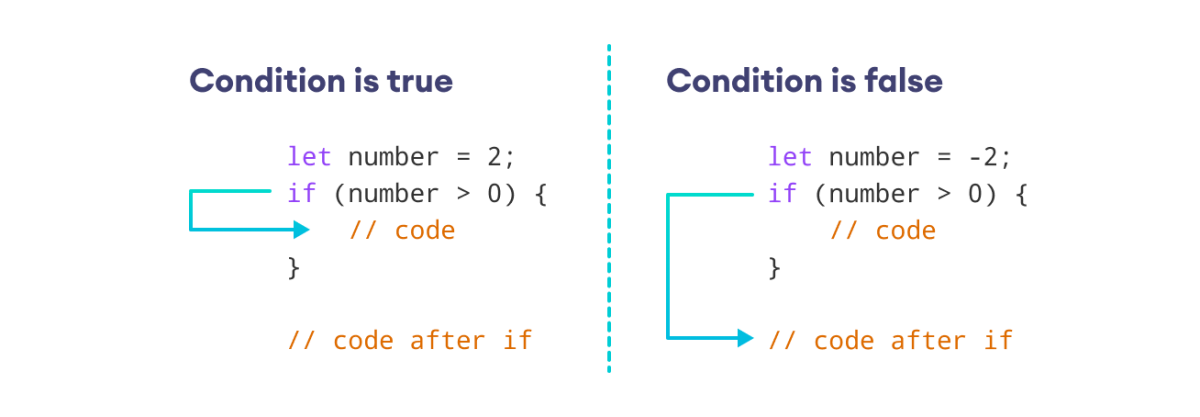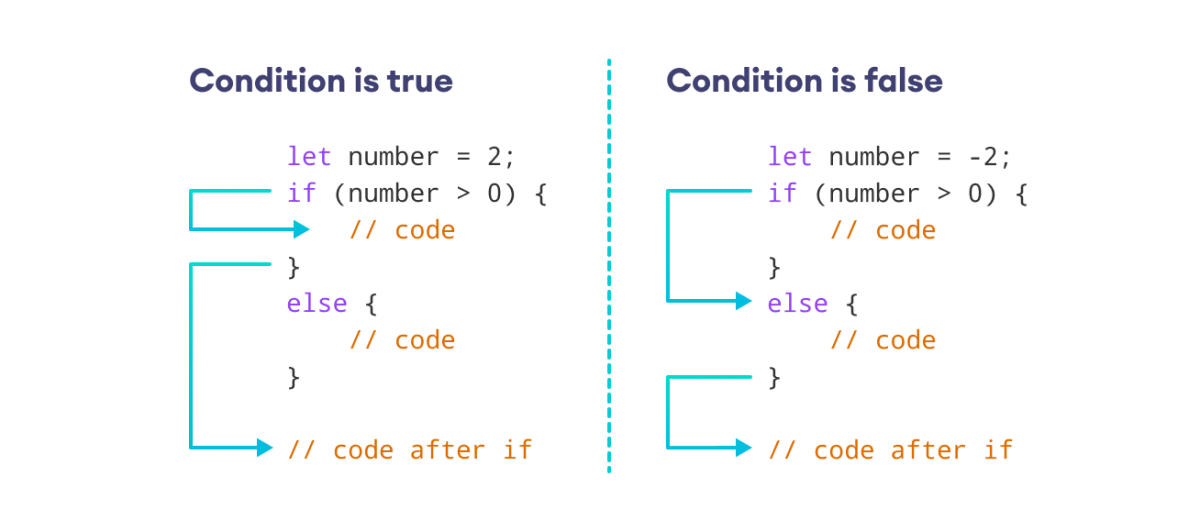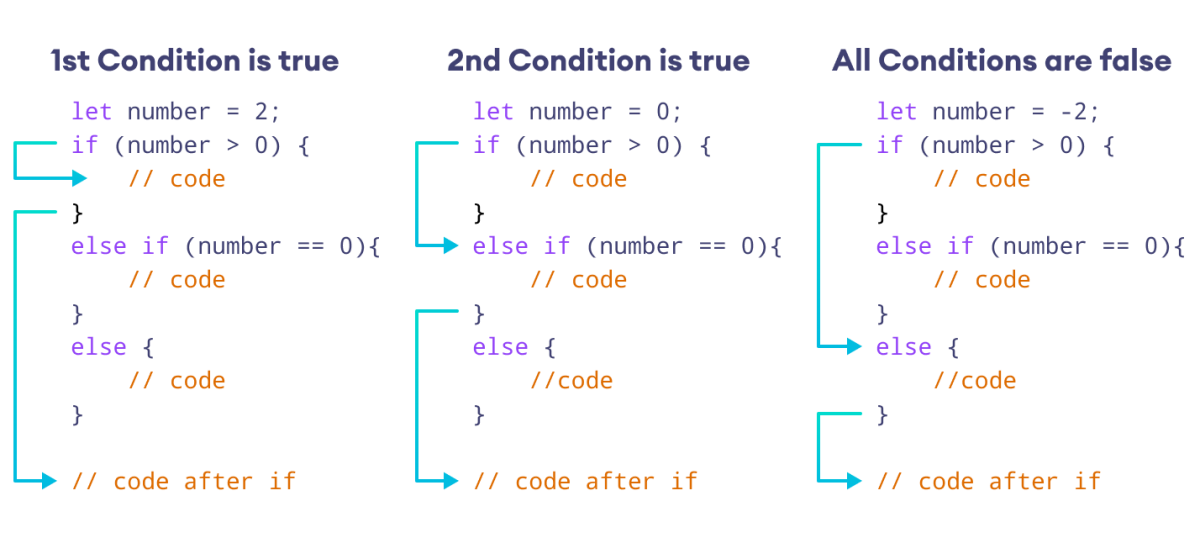The JavaScript if...else statement is used to execute/skip a block of code based on a condition.
Here's a quick example of the if...else statement. You can read the rest of the tutorial if you want to learn about if...else in greater detail.
Example
let score = 45;
// check if score is fifty or greater
if (score >= 50) {
console.log("You passed the examination.");
}
else {
console.log("You failed the examination.");
}
// Output: You failed the examination.
In the above example, the program displays You passed the examination. if the score variable is equal to 50. Otherwise, it displays You failed the examination.
JavaScript if...else Statement
In computer programming, the if...else statement is a conditional statement that executes a block of code only when a specific condition is met. For example,
Suppose we need to assign different grades to students based on their scores.
- If a student scores above 90, assign grade A.
- If a student scores above 75, assign grade B.
- If a student scores above 65, assign grade C.
These conditional tasks can be achieved using the if...else statement.
JavaScript if Statement
We use the if keyword to execute code based on some specific condition.
The syntax of if statement is:
if (condition) {
// block of code
}
The if keyword checks the condition inside the parentheses ().
- If the condition is evaluated to
true, the code inside{ }is executed. - If the condition is evaluated to
false, the code inside{ }is skipped.
Note: The code inside { } is also called the body of the if statement.

Example 1: JavaScript if Statement
// Program to check if the number is positive
const number = prompt("Enter a number: ");
// check if number is greater than 0
if (number > 0) {
// the body of the if statement
console.log("positive number");
}
console.log("nice number");
Sample Output 1
Enter a number: 5 positive number nice number
In the above program, when we enter 5, the condition number > 0 evaluates to true. Thus, the body of the if statement is executed.
Sample Output 2
Enter a number: -1 nice number
Again, when we enter -1, the condition number > 0 evaluates to false. Hence, the body of the if statement is skipped.
Since console.log("nice number"); is outside the body of the if statement, it is always executed.
Note: We use comparison and logical operators in our if conditions. To learn more, you can visit JavaScript Comparison and Logical Operators.
JavaScript else Statement
We use the else keyword to execute code when the condition specified in the preceding if statement evaluates to false.
The syntax of the else statement is:
if (condition) {
// block of code
// execute this if condition is true
}
else {
// block of code
// execute this if condition is false
}
The if...else statement checks the condition and executes code in two ways:
- If
conditionis true, the code insideifis executed. And, the code insideelseis skipped. - If
conditionis false, the code insideifis skipped. Instead, the code insideelseis executed.

Example 2: JavaScript if…else Statement
let age = 17;
// if age is 18 or above, you are an adult
// otherwise, you are a minor
if (age >= 18) {
console.log("You are an adult");
}
else {
console.log("You are a minor");
}
// Output: You are a minor
In the above example, the if statement checks for the condition age >= 18.
Since we set the value of age to 17, the condition evaluates to false.
Thus, the code inside if is skipped. And, code inside else is executed.
We can omit { } in if…else statements when we have a single line of code to execute. For example,
let num = 4;
// if condition
if (num % 2 == 0)
console.log("even number");
else
console.log("odd number");
// Output: even number
JavaScript else if Statement
We can use the else if keyword to check for multiple conditions.
The syntax of the else if statement is:
// check for first condition
if (condition1) {
// if body
}
// check for second condition
else if (condition2){
// else if body
}
// if no condition matches
else {
// else body
}
Here,
- First, the condition in the
ifstatement is checked. If the condition evaluates totrue, the body ofifis executed, and the rest is skipped. - Otherwise, the condition in the
else ifstatement is checked. Iftrue, its body is executed and the rest is skipped. - Finally, if no condition matches, the block of code in
elseis executed.

Example 3: JavaScript if...else if Statement
let rating = 4;
// rating of 2 or below is bad
// rating of 4 or above is good
// else, the rating is average
if (rating <= 2) {
console.log("Bad rating");
}
else if (rating >= 4) {
console.log("Good rating!");
}
else {
console.log("Average rating");
}
// Output: Good rating!
In the above example, we used the if statement to check for the condition rating <= 2.
Likewise, we used the else if statement to check for another condition, rating >= 4.
Since the else if condition is satisfied, the code inside it is executed.
We can use the else if keyword as many times as we want. For example,
let alphabet = "c";
if (alphabet == "a") {
console.log("a for apple");
}
// first else if statement
else if (alphabet == "b") {
console.log("b for banana");
}
// second else if statement
else if (alphabet == "c") {
console.log("c for cat");
}
// use more else if statements if needed
// otherwise, use an else statement
else {
console.log("unknown alphabet");
}
// Output: c for cat
In the above example, we used two else if statements.
The second else if statement was executed as its condition was satisfied.
Nested if...else Statement
When we use an if...else statement inside another if...else statement, we create a nested if...else statement. For example,
let marks = 60;
// outer if...else statement
// student passed if marks 40 or above
// otherwise, student failed
if (marks >= 40) {
// inner if...else statement
// Distinction if marks is 80 or above
if (marks >= 80) {
console.log("Distinction");
}
else {
console.log("Passed");
}
}
else {
console.log("Failed");
}
// Output: Passed
Outer if...else
In the above example, the outer if condition checks if a student has passed or failed using the condition marks >= 40. If it evaluates to false, the outer else statement will print Failed.
On the other hand, if marks >= 40 evaluates to true, the program moves to the inner if...else statement.
Inner if...else statement
The inner if condition checks whether the student has passed with distinction using the condition marks >= 80.
If marks >= 80 evaluates to true, the inner if statement will print Distinction.
Otherwise, the inner else statement will print Passed.
Note: Avoid nesting multiple if…else statements within each other to maintain code readability and simplify debugging.
More on JavaScript if...else Statement
We can use the ternary operator ?: instead of an if...else statement if the operation we're performing is very simple. For example,
let grade = 40;
let result;
if (grade >= 50)
result = 'pass'
else
result = 'fail'
console.log(result)
can be written as
let grade = 40;
let result = (grade >= 50) ? 'pass' : 'fail';
console.log(result)
We can replace our if…else statement with the switch statement when we deal with a large number of conditions.
For example,
let grade = "C";
// using if else for many conditions
// first condition
if (grade === "A") {
console.log("Excellent!");
}
// second condition
else if (grade === "B") {
console.log("Good!");
}
// third condition
else if (grade === "C") {
console.log("Average");
}
// fourth condition
else if (grade === "D") {
console.log("Bad");
}
// otherwise, execute else block
else {
console.log("Fail");
}
// Output: Average
In the above example, we used if…else to evaluate five conditions, including the else block.
Now, let's use the switch statement for the same purpose.
let grade = "C";
// using switch...case
switch (grade) {
// first condition
case "A":
console.log("Excellent!");
break;
// second condition
case "B":
console.log("Good!");
break;
// third condition
case "C":
console.log("Average");
break;
// fourth condition
case "D":
console.log("Bad");
break;
default:
console.log("Fail");
}
// Output: Average
As you can see, the switch statement makes our code more readable and maintainable.
In addition, switch is faster than long chains of if…else statements.
We can use logical operators such as && and || within an if statement to add multiple conditions. For example,
let age = 35;
let salary = 6000;
// combine two conditions
// using the "and" operator &&
if (age >= 30 && salary >= 5000) {
console.log("Eligible for premium membership.");
}
else {
console.log("Not eligible for premium membership.");
}
// Output: Eligible for premium membership.
Here, we used the logical operator && to add two conditions in the if statement.
Also Read: